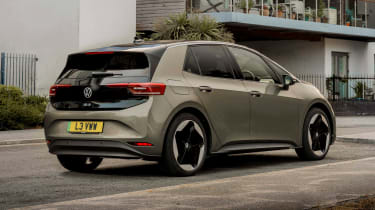Volkswagen ID.3 hatchback - Range, charging & running costs
The range has been simplified, but a choice of battery sizes caters to different customers
The Volkswagen ID.3 is currently available with four different battery sizes and three different electric motors. The smallest 52kWh battery offered in the ID.3 became available in the UK from November 2024, providing buyers with a more affordable option.
Buyers can also choose between the Pro (58kWh) or Pro S (77kWh) offering official ranges of 265 miles and 347 miles respectively, and a 79kWh battery in the GTX with a 375-mile range. There is currently no option to choose the cheaper specification with the bigger battery or vice versa.
Volkswagen ID.3 range & charging time
The 52kWh model has an all-electric driving range of around 240 miles, while the bigger-battery 58kWh model (badged Pro from mid-2023) will do around 265 miles, while the 77kWh Pro S is capable of up to 347 miles on a charge and the 79kWh GTX range-topper up to 375 miles. As with any electric car, it’s worth noting that range will be lower than the quoted figures in real-world driving, and shorter still in cold weather, though both the Pro S and GTX should pass the 300-mile mark in normal driving without much effort.
The range offered on Pro models is likely to be adequate for most buyers, and shouldn’t be sniffed at – the near-£6k saving over the flagship Pro S means this is the version we’d recommend – unless the entry-level battery will suffice for your needs. But if you find yourself doing longer trips, those cars with the biggest battery are certainly worth considering – not least because they also offer faster 170kW maximum charge speeds.
That’s not to say the Pro models are hampered with slow charge rates; models fitted with the 58kWh battery max out at 120kW, which should still be sufficient for a 10-80% top up in a little over half an hour. Pro S cars slash this benchmark charge to 28 minutes, despite their bigger battery. The entry-level Pure trims have slightly slower 145kW charging, but a smaller battery capacity means 10-80% only takes a respectable 25 minutes.
Charging via a home wallbox (at 11kW) takes 6 hours and 15 minutes for the 58kWh model and 7 hours 30 minutes for the 77kWh car – or a little longer via a more common 7kW connection.
Check out our guide to the best chargepoint providers here.
Tax costs
VED (road tax) will no longer be free from April 2025, but it’s still cheaper than combustion-engined cars in the first year, while recharging at home costs less than filling a fuel tank – although how much cheaper it works out depends on your electricity tariff.
The Benefit-in-Kind rate of 2% means that all electric cars are extremely cost-effective for company-car buyers. If your commute isn’t abnormally long or if you can charge at home or work, then the ID.3 could be a great way to save money on company-car tax.










